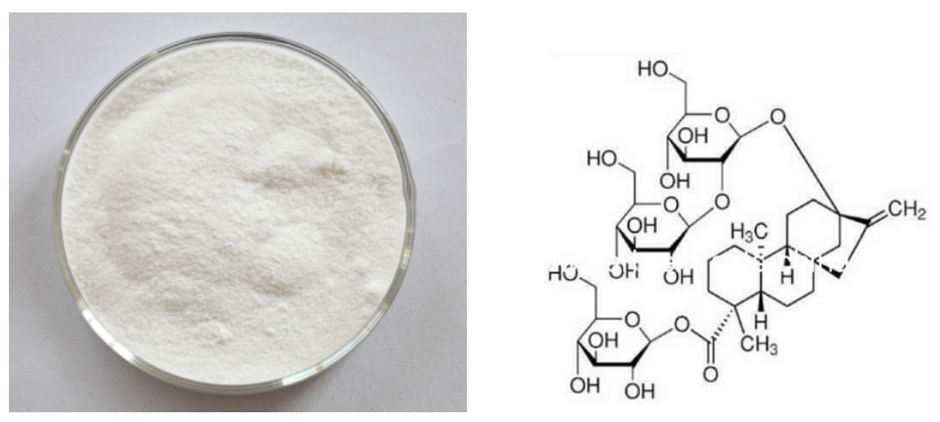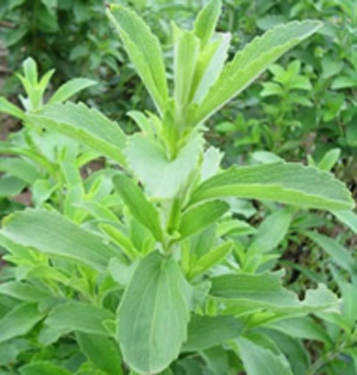China Professional Supplier Stevia Extract in Salt Lake City
China Professional Supplier Stevia Extract in Salt Lake City Detail:
[Latin Name] Stevia rebaudiana
[Plant Source]from China
[Specifications] 1.Stevia Extract Powder (Steviosides)
Total Steviol Glycosides 80%, 90%, 95%
2. Rebaudioside-A
Rebaudioside-A 40%, 60%, 80%, 90%, 95%, 98%
3. Stevioside 90%
One monomer in Steviol Glycosides
[Appearance] Fine white powder
Plant Part Used:Leaf
[Particle size] 80 Mesh
[Loss on drying] ≤5.0%
[Heavy Metal] ≤10PPM
[Shelf life] 24 Months
[Package] Packed in paper-drums and two plastic-bags inside.
[Net weight] 25kgs/drum
Stevia Extract
[Characteristics]
Stevia sugar features high sweetness and low calorie and its sweetness is 200 350 times of that of cane sugar but its calorie is only 1/300 of that of cane sugar.
The component of stevia extract that gives it its sweetness is a mixture of various steviol glycosides. The components of sweetness in stevia leaves are stevioside, rebaudioside A, C, D, E and dulcoside A. Rebaudioside C, D, E and dulcoside A are small in quantity. The principal components are stevioside and rebaudioside A.
The quality of stevioside and rebaudiosideA is better than those of other components, which are commercially extracted and used in various applications.
The steviol glycosides present in stevia extract are referred to as “steviosides” or ¡°stevia extract¡±. Among these “steviosides”, the most common is Stevioside followed by RebaudiosideA. The Stevioside has a slight and pleasant herbal taste and the Rebaudioside-A has no herbal taste.
Although Rebaudioside C and dulcoside A are small in quantity in stevia extract, they are the major components giving bitter aftertaste.
[Function]
A large number of pharmaceutical tests have proved that stevia sugar has no side effects, carcinogens, and is safe for eating.
Compared with cane sugar, it can save 70% of the cost. With pure white color, pleasing taste and no peculiar smell, Stevia sugar is a new sugar source with broad perspective for development. Stevia rebaudianum sugar is the natural low hotsweet agent mostly similar to the flavor of cane sugar, approved to be used by State Ministry of Health and Ministry of Light Industry.
It is the third natural succedaneum of cane sugar and beet sugar with development and health care value, extracted from the leaves of the herbal vegetable of the composite family-stevia rebaudianum.
Product detail pictures:

Related Product Guide:
We retain bettering and perfecting our goods and service. At the same time, we perform actively to do research and enhancement for China Professional Supplier Stevia Extract in Salt Lake City , The product will supply to all over the world, such as: Mozambique, Australia, Gabon, Our professional engineering group will always be ready to serve you for consultation and feedback. We are able to also offer you with absolutely free samples to meet your requirements. Finest efforts will likely be produced to give you the ideal service and goods. For anyone who is thinking about our company and merchandise, please contact us by sending us emails or contact us quickly. As a way to know our merchandise and firm. lot more, you can come to our factory to find out it. We'll always welcome guests from all over the world to our business to build company relations with us. Please feel free to get in touch with us for business and we believe we are going to share the top trading practical experience with all our merchants.
https://www.ImmiFlex.com – Donald J. Cox, Ph.D., talks about the history of beta glucans, soluble carbohydrates discovered well over a century ago and found in the cell walls of different plant materials, mushrooms, bacteria and yeast. He continues to point out that the health benefits depend on structural differences between the different beta glucans.
It has been discovered that yeast beta glucans have a chemical structure that is recognized by immune cells and that are different from other types of beta glucans. See our other videos with Mr. Donald J. Cox to learn more about the safety and clinically documented health benefits of these particular yeast beta glucans.
Donald J. Cox is the Senior Vice President of Healthcare Research and Development at Biothera.
This video is published courtesy of iHealthTube.com and original video can be found here: https://youtu.be/hqxh2Sz4OTU
if u like my video, hit the like button and subscribe my chnnel..
if you have some questions about my recipes then comment in comment box,,,, otherwise mail me
(panigrahyreena@gmail.com)
INGREDIANTS.
PARWAL – 1 CUP
CORN FLOUR – 1 CUP
BESAN – 1 CUP
SESAME – 1/2 CUP
GINGER/GARLIC PASTE – 2 TSP
SALT -AS PER YOUR TASTE
TURMERIC POWDER – 1 TSP
RED CHILLI POWDER – 3 TSP
WATER – 1/2 GLASS
GARAM MASALA POWDER – 1 TSP
CUMIN SEED POWDER – 1 SPOON
CORIANDER POWDER – 1 SPOON
The company's products can meet our diverse needs, and the price is cheap, the most important is that the quality is also very nice.







